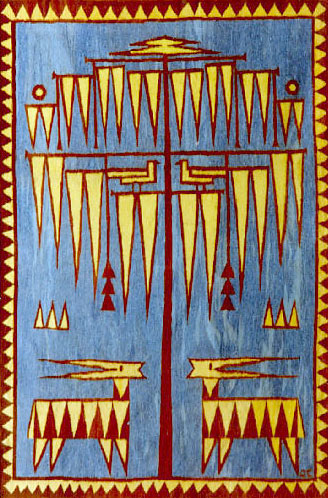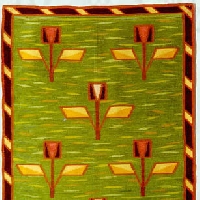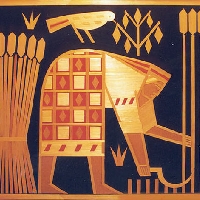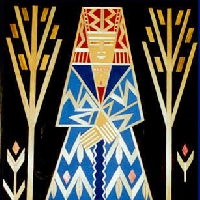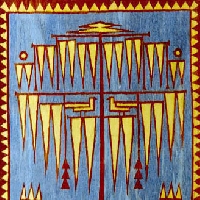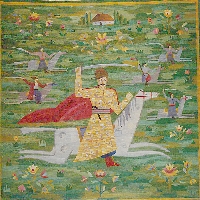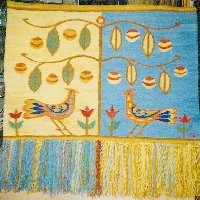Olexandr Sayenko, People's Artist of the UkrSSR, belongs to the older generation of Soviet Ukrainian artists.
From the very first years of Soviet power he endeavoured to link his creative works with the life of the working people, with their struggle for a new social system.
Olexandr Sayenko's creative work, like his whole life, is rather unusual.
Deaf-and-dumb from early childhood (Sayenko was born into the family of a teacher and gardener on August 20, 1899, in the town of Borzna, Chernigov Province), he grew up in a world all his own. But as occasionally happens, the loss of hearing sharpened his eye. The charming landscapes of his native land, the beauty of works of folk art and his close connection with Ukrainian folk-lore and peasant life, all played an important role in fostering a poetic vision of the surrounding world within the future artist.
A remarkable feeling for colour appeared very early in Sayenko's character. Once, upon viewing traditional decorative articles made by folk artisans, he was particularly impressed by those ornamented with straw inlay and realized the tremendous effectiveness colour could play in conveying his thoughts and feelings as an artist.
Sayenko began making picture frames and bowls which he adorned with straw inlays typical of Chernigov Province folk art.
With the assistance of Pyotr Ghe, a Petersburg lawyer and son of the famous Russian artist Nikolai Ghe, Sayenko was enrolled in the Petersburg school for the deaf and dumb. At the school he became acquainted with the fundamentals of visual arts and with Russian realist art.
After finishing the school in 1916, he returned to Borzna where he continued his education in the studio of Andronik Lazarchuk, an artist and instructor who in his time had graduated from the Petersburg Academy of Fine Arts. It was at this particular time that Sayenko became attracted by the technique of making straw inlays, and produced a variety of ornamental pieces that embodied it.
The Great October Socialist Revolution made it possible for Sayenko to receive a higher art education. In 1920 he entered the Kiev Institute of Art where he attended the studio classes of the well-known artist and architect Vasiliy Krichevsky, specializing in the art of interior decoration. Sayenko's urge to seriously study folk art was stimulated by Professor Krichevsky. At that time Sayenko produced works of art using various media: his "Portrait of Matryona Sayenko" (1922) was done in oils, "Woman's Portrait" (1924), "Mounted Cossack" (1922) and "Shepherd with Sheep" (1922) in water colour, and "Woman's Portrait" (1925) in tempera.
But the artist was particularly successful when he created works devoted to grain-growers. In the 1920s he made straw-inlay panels which became rather widely known: "Geese under a Pussy-Willow" (1920), "She was Harvesting Wheat for the Landlord" (1920), "Ukrainian Village" (1922) and "On Guard for the USSR Borders" (19221929).
In 1928 Sayenko graduated from the Institute of Art (his diploma work was "Interior Decor for Village Soviet"). The same year, in collaboration with Vasiliy Krichevsky, he made the decorative interior designs for the historical section of the UkrSSR Academy of Sciences, also the straw inlay panels entitled "National Hero Cossack Mamai Singing a Ukrainian Ballad" (1928), and "Slaves" (1928) based on T. Shevchenko's verse. Noted for their monumental composition and arrow-like straight lines, stipulated by the technique and materials employed, the panels harmonize perfectly with the architectural forms of the interiors.
Sayenko's approach to working with straw makes his inlay compositions resemble mosaics. The only difference lies in the fact that the artist uses ordinary straw of various colours, sometimes tinted, in place of cubes of stone or smalto. Cut in strips or pieces and pressed out smoothly, the straw is pasted onto a wooden board where the design has previously been drawn. This permits the achievement of linear and sharply arrow-like forms which have much in common with geometric ornament typical of Ukrainian folk art. The background surface surrounding the ornament is painted in gouache, using colours harmonizing with the golden-yellow of the straw inlay design.
Since graduating from the Institute, the artist has never left his native town of Borzna and devotes all his works to the life and work of his fellow townsmen.
Sayenko's creative work first won public recognition at the First Republican Exhibition of Folk Art in 1936 where his panel "Dance" (1936) was on show. From 1939 to 1940 he made a number of panels for the UkrSSR Pavilion at the Аll-Union Agricultural Exhibition: "Apple Picking," "Dance," "Shepherd" and "Collective Farmerette."
In the 1960s Sayenko made his "Festive Day" and "Spring," panels noted for bright colour, brimming over with life. Colour in these works plays the very important role of conveying the lyrical mood of the scenes depicted.
In 1961 Sayenko's productions were: the panel "Corn Husking" which is monumental in composition and has an interesting colour treatment the dominating emerald-green of the meadows and fields is in perfect harmony with the yellow of the straw inlay; the panel "The Broad Dnieper is Roaring and Groaning," inspired by T. Shevchenko's poetry; and the panel made for the Hotel Dnipro's cafe in Kiev, which so naturally blends with the cafe's modern well-lit interior. Sayenko's creative works have eloquently proved that straw inlay is an excellent medium for monumental compositions. In 1962 the artist's one-man show was held.
The acme of Sayenko's creative work is the panel entitled "Ballad of the Grain" (1973) whose unusual imagery attracted the special attention of viewers. Actually, it is a monumental epic relating the story of the people's age-old struggle for bread and freedom, and lauding the present day. The windmill, which is the panel's compositional focus and a mute witness of bygone centuries as well as today's prosperity, has the effect of a unique monument to the grain growers' success. The panel is a paean of praise to the Ukraine's industrious farmers.
The last-mentioned and his other panels of the Sixties have a feature in common that is rather typical of Sayenko's creative work during that period: the total space of straw inlay dominates over the rest of the background, so that the whole work simply gleams with a medley of varied golden tints.
Straw inlay today enjoys such wide popularity that it would be well-nigh impossible to overestimate the contribution made to the craft by Olexandr Sayenko, People's Artist of the UkrSSR and one of the founders of this art form.
Olexandr Sayenko, People's Artist of the UkrSSR, belongs to the older generation of Soviet Ukrainian artists.
From the very first years of Soviet power he endeavoured to link his creative works with the life of the working people, with their struggle for a new social system.
Olexandr Sayenko's creative work, like his whole life, is rather unusual.
Deaf-and-dumb from early childhood (Sayenko was born into the family of a teacher and gardener on August 20, 1899, in the town of Borzna, Chernigov Province), he grew up in a world all his own. But as occasionally happens, the loss of hearing sharpened his eye. The charming landscapes of his native land, the beauty of works of folk art and his close connection with Ukrainian folk-lore and peasant life, all played an important role in fostering a poetic vision of the surrounding world within the future artist.
A remarkable feeling for colour appeared very early in Sayenko's character. Once, upon viewing traditional decorative articles made by folk artisans, he was particularly impressed by those ornamented with straw inlay and realized the tremendous effectiveness colour could play in conveying his thoughts and feelings as an artist.
Sayenko began making picture frames and bowls which he adorned with straw inlays typical of Chernigov Province folk art.
With the assistance of Pyotr Ghe, a Petersburg lawyer and son of the famous Russian artist Nikolai Ghe, Sayenko was enrolled in the Petersburg school for the deaf and dumb. At the school he became acquainted with the fundamentals of visual arts and with Russian realist art.
After finishing the school in 1916, he returned to Borzna where he continued his education in the studio of Andronik Lazarchuk, an artist and instructor who in his time had graduated from the Petersburg Academy of Fine Arts. It was at this particular time that Sayenko became attracted by the technique of making straw inlays, and produced a variety of ornamental pieces that embodied it.
The Great October Socialist Revolution made it possible for Sayenko to receive a higher art education. In 1920 he entered the Kiev Institute of Art where he attended the studio classes of the well-known artist and architect Vasiliy Krichevsky, specializing in the art of interior decoration. Sayenko's urge to seriously study folk art was stimulated by Professor Krichevsky. At that time Sayenko produced works of art using various media: his "Portrait of Matryona Sayenko" (1922) was done in oils, "Woman's Portrait" (1924), "Mounted Cossack" (1922) and "Shepherd with Sheep" (1922) in water colour, and "Woman's Portrait" (1925) in tempera.
But the artist was particularly successful when he created works devoted to grain-growers. In the 1920s he made straw-inlay panels which became rather widely known: "Geese under a Pussy-Willow" (1920), "She was Harvesting Wheat for the Landlord" (1920), "Ukrainian Village" (1922) and "On Guard for the USSR Borders" (19221929).
In 1928 Sayenko graduated from the Institute of Art (his diploma work was "Interior Decor for Village Soviet"). The same year, in collaboration with Vasiliy Krichevsky, he made the decorative interior designs for the historical section of the UkrSSR Academy of Sciences, also the straw inlay panels entitled "National Hero Cossack Mamai Singing a Ukrainian Ballad" (1928), and "Slaves" (1928) based on T. Shevchenko's verse. Noted for their monumental composition and arrow-like straight lines, stipulated by the technique and materials employed, the panels harmonize perfectly with the architectural forms of the interiors.
Sayenko's approach to working with straw makes his inlay compositions resemble mosaics. The only difference lies in the fact that the artist uses ordinary straw of various colours, sometimes tinted, in place of cubes of stone or smalto. Cut in strips or pieces and pressed out smoothly, the straw is pasted onto a wooden board where the design has previously been drawn. This permits the achievement of linear and sharply arrow-like forms which have much in common with geometric ornament typical of Ukrainian folk art. The background surface surrounding the ornament is painted in gouache, using colours harmonizing with the golden-yellow of the straw inlay design.
Since graduating from the Institute, the artist has never left his native town of Borzna and devotes all his works to the life and work of his fellow townsmen.
Sayenko's creative work first won public recognition at the First Republican Exhibition of Folk Art in 1936 where his panel "Dance" (1936) was on show. From 1939 to 1940 he made a number of panels for the UkrSSR Pavilion at the Аll-Union Agricultural Exhibition: "Apple Picking," "Dance," "Shepherd" and "Collective Farmerette."
In the 1960s Sayenko made his "Festive Day" and "Spring," panels noted for bright colour, brimming over with life. Colour in these works plays the very important role of conveying the lyrical mood of the scenes depicted.
In 1961 Sayenko's productions were: the panel "Corn Husking" which is monumental in composition and has an interesting colour treatment the dominating emerald-green of the meadows and fields is in perfect harmony with the yellow of the straw inlay; the panel "The Broad Dnieper is Roaring and Groaning," inspired by T. Shevchenko's poetry; and the panel made for the Hotel Dnipro's cafe in Kiev, which so naturally blends with the cafe's modern well-lit interior. Sayenko's creative works have eloquently proved that straw inlay is an excellent medium for monumental compositions. In 1962 the artist's one-man show was held.
The acme of Sayenko's creative work is the panel entitled "Ballad of the Grain" (1973) whose unusual imagery attracted the special attention of viewers. Actually, it is a monumental epic relating the story of the people's age-old struggle for bread and freedom, and lauding the present day. The windmill, which is the panel's compositional focus and a mute witness of bygone centuries as well as today's prosperity, has the effect of a unique monument to the grain growers' success. The panel is a paean of praise to the Ukraine's industrious farmers.
The last-mentioned and his other panels of the Sixties have a feature in common that is rather typical of Sayenko's creative work during that period: the total space of straw inlay dominates over the rest of the background, so that the whole work simply gleams with a medley of varied golden tints.
Straw inlay today enjoys such wide popularity that it would be well-nigh impossible to overestimate the contribution made to the craft by Olexandr Sayenko, People's Artist of the UkrSSR and one of the founders of this art form.
